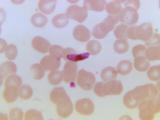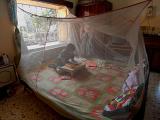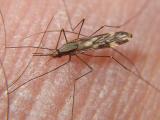Over a recent 15-year period, close to 1,500 US travelers a year were hospitalized for treatment of malaria acquired overseas, far more than were treated for other travel-related diseases, according to a study published yesterday on the eve of World Malaria Day.
In related news, the World Health Organization (WHO) announced yesterday that a pilot program for administering the world's first malaria vaccine to young children will be conducted in Ghana, Kenya, and Malawi starting next year.
Imported cases cost $555 million
Malaria transmission in the United States was stopped in the 1950s, but a steady stream of travelers are bringing the disease home with them, suggesting that many travelers are not taking adequate precautions, according to the study published in the American Journal of Tropical Medicine and Hygiene (AJTMH).
Researchers looked for malaria cases in hospitalization discharge records in the 2000 to 2014 Nationwide Inpatient Sample, according to the report. They estimated there were 22,029 malaria-related hospitalizations over the 15 years, or 4.88 per million population, with 4,823 severe cases and 182 in-hospital deaths.
"It appears more and more Americans are traveling to areas where malaria is common and many of them are not taking preventive measures, such as using anti-malarial preventive medications and mosquito repellents, even though they are very effective at preventing infections," Diana Khuu, PhD, MPH, lead author of the study, said in an AJTMH news release. She is a scientist at the University of California, Los Angeles.
The findings showed that malaria-linked hospitalizations, averaging 1,489 per year, were far more common than hospitalizations for most other travel-related diseases, according to the release. For example, dengue fever, which is common in Latin America, accounted for 259 hospitalizations per year over the same period.
The malaria patients were hospitalized for an average of 4.36 days, at an average cost of $25,789, the report said. The total cost of the cases over the 15 years came to about $555 million.
The burden fell disproportionately on patients who were male, black, or 25 to 44 years old, the study found. Plasmodium falciparum malaria—the most deadly type—accounted for most of the hospitalizations, and August was the month with the most cases.
Since about 69% of all malaria patients need hospital treatment, the scientists estimated that about 2,100 people in the United States have malaria each year, according to the release.
Khuu commented that mosquitoes capable of carrying malaria are common in parts of the United States, and that increases in the number of travelers coming home with the disease increase the risk of re-establishing the disease in the country. But the study found no significant change in the rate of malaria hospitalizations over the study period.
Malaria vaccinations planned in Africa
Meanwhile, plans to give the new malaria vaccine, called RTS,S, to children in parts of Ghana, Kenya, and Malawi were announced yesterday by the WHO's Regional Office for Africa. The vaccine was developed to protect young children from P falciparum malaria.
The pilot program will assess whether the vaccine's protective effect in children 5 to 17 months old, shown in phase 3 testing, can be replicated in real life, the WHO said. Specifically, the program will test the feasibility of delivering the required four doses of RTS,S, the vaccine's potential role in reducing childhood deaths, and its safety in routine use.
WHO officials describe the vaccine as a complementary tool that could be added to the core package of WHO-recommended measures for preventing malaria, including insecticide-treated bed nets, spraying indoor walls with insecticides, and preventive medicines for pregnant women and young children.
Ghana, Kenya, and Malawi were chosen for the program because they have high coverage with treated bed nets, good malaria and immunization programs, high malaria burdens, and participation in the RTS,S phase 3 trials, the WHO said.
RTS,S was developed by GlaxoSmithKline (GSK) and is the first malaria vaccine to succeed in a phase 3 trial, the WHO noted. In 2015, two WHO advisory groups recommended pilot vaccination programs in three to five settings in sub-Saharan Africa.
Several non-governmental global health agencies are partnering to provide $49.2 million for the first phase of the pilot program (2017 to 2020), which will be complemented by in-kind contributions from the WHO and GSK, the WHO said.
WHO cites progress, challenges
In other malaria news, the WHO yesterday reported progress and big remaining challenges in the battle against the disease. The agency said the rate of new malaria cases fell by 21% globally from 2010 to 2015, and death rates fell by 29% in the same 5-year period. In sub-Saharan Africa, which bears 90% of the malaria burden, cases and death rates fell by 21% and 31%, respectively.
Still, in 2015 the global malaria toll was 429,000 deaths and 212 million new cases, with one child dying from malaria every 2 minutes, the WHO said.
The agency's long-term malaria strategy calls for reducing cases and deaths by 90% and eliminating the disease in at least 35 countries by 2030. Interim 2020 targets call for 40% reductions in cases and death rates and for eliminating malaria in at least 10 countries.
Funds for malaria prevention, research
Other malaria news related to World Malaria Day included announcements about grants for malaria prevention and research:
- The Global Fund to Fight AIDS, Tuberculosis, and Malaria said today it would provide more than $242 million over 3 years to continue the battle against malaria in Cambodia, Thailand, Myanmar, Laos, and Vietnam. The grant will be the group's largest regional allocation and the first with the specific goal of eliminating the disease in a specific region. The step continues the fund's Regional Artemisinin-resistance Initiative, launched in 2013.
- The US National Institute of Allergy and Infectious Diseases (NIAID) announced late last week it would provide about $9 million in first-year funding for seven malaria research centers around the world. The awards will go to three new and four existing centers that work in 14 countries in Africa, Asia, and Latin America. The 7-year awards continue NIAID's 2010 program that created the International Centers of Excellence for Malaria Research (ICEMRs) in regions where malaria is endemic.
See also:
Arp 24 AJTMH abstract
Apr 24 AJTMH press release
Apr 24 WHO-Africa press release on vaccination program
Apr 24, 2015, CIDRAP News story "First malaria vaccine shows promise despite efficacy drop-off"
Oct 23, 2015, CIDRAP News story "WHO experts urge gradual rollout of malaria vaccine"
Apr 24 WHO press release on malaria progress and challenges



















